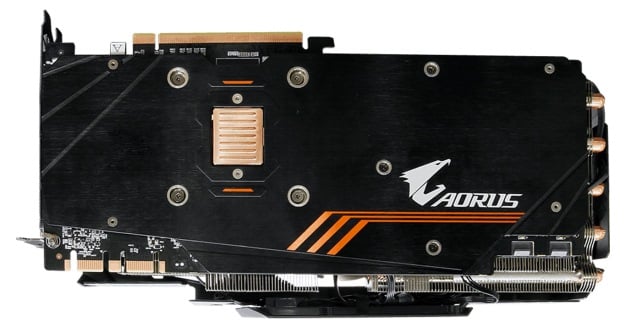Gigabyte Aorus GeForce GTX 1080 Ti 11GB Review: A Custom, Overclocked Beast
Gigabyte Aorus GeForce GTX 1080 Ti - One Bad Ass GPU
NVIDIA shook up the top of the graphics card market a couple of weeks back with the release of the GeForce GTX 1080 Ti. In its stock, Founder’s Edition form, the GeForce GTX 1080 Ti proved to be the fastest consumer-class graphics card available, but that didn’t stop NVIDIA’s board partners from quickly announcing custom versions packing even more horsepower. Case in point: The beastly Gigabyte Aorus GeForce GTX 1080 Ti 11GB we will be showing you here. The Gigabyte Aorus GeForce GTX 1080 Ti 11GB is the first, fully-custom, factory-overclocked (and ready to rock) GTX 1080 Ti to hit the lab, and we’ve just finished putting it through its paces.
Gigabyte has tweaked and modified virtually every part of the GTX 1080 Ti with this product. The Aorus card’s cooler, PCB, display outputs, and just about everything in between, differ from NVIDIA’s Founder’s Edition. Take a look at the Gigabyte Aorus GeForce GTX 1080 Ti 11GB’s specs below, and then we’ll take a tour of this behemoth so you can see just what we mean. And then strap yourselves in and hide your credit cards before checking out the benchmarks...this thing’s a screamer...
The Gigabyte Aorus GeForce GTX 1080 Ti offers two modes of operation; there’s a gaming mode in which the card’s GPU operates with a base clock of 1569MHz and a boost clock of 1683MHz and an OC mode with a base clock of 1594MHz and boost clock of 1708MHz. The mode is easily switchable with the included Aorus Graphics Engine software, but as you’ll see a little later even that 1708MHz boost clock is rather conservative. With minimal tweaking this card will run much faster.
Everything about the Gigabyte Aorus GeForce GTX 1080 Ti is custom. The PCB is packing a 12+2 phase power array, that’s outfitted with the same type of chokes and capacitors used on the much more expensive Titan X. And the power connectors feature LEDs to indicate that the card is properly connected to the PSU. There is a protective back-plate that also doubles as a heat-plate, and the card’s cooler is obviously quite different than anything else out there.
Gigabyte calls the cooler its Windforce Stack 3X. The name stems from the fact that there are three fans that are stacked in a somewhat unique arrangement. The middle fan actually sits below the two outer fans, and their blades overlap one another. The fans also spin in opposing directions. Gigabyte claims this setup decreases turbulence, eliminated dead spots, and optimizes air-flow though the massive heatsink underneath. We don’t have a means to substantiate those claims, but we can say that the cooler remains very quiet – even under load – and it does a great job at keeping things cool as well (more on that later).
Beneath the fans is a large heatsink array, with angular fins to increase surface area, that’s linked together with thick copper heat-pipes. The heat-sink is mounted onto a copper base-plate, which makes direct contact with the GPU and all 11GB of GDDR5X RAM on the card. Another base-plate also makes direct contact with the VRM. We should mention that the back-side of the VRM makes direct contact the rear-plate as well, and there’s an additional copper heat-sink on the back of the GPU too.
There is a ton of metal and moving air on the Gigabyte Aorus GeForce GTX 1080 Ti all working together to keep the card cool. On the plus side, the assembly works very well and it remains quiet during normal operation. On the down side, it is a huge, triple-slot solution. That probably won’t mean much to many of you, but keep in mind that the card ultimately consumes three slots, so SLI might not be an option with some motherboards, depending on the slot spacing.
In addition to the fans and heatsink, the shroud on the Gigabyte Aorus GeForce GTX 1080 Ti packs a number of RGB LEDs and lighted brand markings that can be customized to virtually any color. The outputs on the card have been tweaked as well. There is actually an internal HDMI connector nestled at the back of the PCB, under the heatsink, to facilitate connecting a front-mounted HDMI port for VR setups. Gigabyte also kept the DVI port on the card. All told, there are seven display outputs on the Gigabyte Aorus GeForce GTX 1080 Ti – 3xHDMI ports, 3xDisplayPorts, and the DVI output -- but only 4 can be used simultaneously at any given time. If the DVI port is used, one of the HDMI connectors is disabled.
Gigabyte has tweaked and modified virtually every part of the GTX 1080 Ti with this product. The Aorus card’s cooler, PCB, display outputs, and just about everything in between, differ from NVIDIA’s Founder’s Edition. Take a look at the Gigabyte Aorus GeForce GTX 1080 Ti 11GB’s specs below, and then we’ll take a tour of this behemoth so you can see just what we mean. And then strap yourselves in and hide your credit cards before checking out the benchmarks...this thing’s a screamer...
|
| Graphics Processing | GeForce GTX 1080 Ti |
| Core Clock | Boost: 1708 MHz / Base: 1594 MHz in OC mode Boost: 1683 MHz / Base: 1569 MHz in Gaming mode |
| Memory Clock | 11010 MHz |
| Memory Size | 11 GB |
| Memory Type | GDDR5X |
| Memory Bus | 352 bit |
| Output | Dual-link DVI-D *1 HDMI-2.0b*3 (Max Resolution: 4096x2160 @60 Hz) Display Port-1.4 *3 (Max Resolution: 7680x4320 @60 Hz) (Standard mode: Dual-link DVI-D*1, DP1.4*3, HDMI 2.0b*1) (VR mode: DP*3, HDMI*3) |
| Digital max resolution | 7680x4320 |
| Card size | H=55 L=293 W=142 mm |
| Recommended PSU | 600W |
| Power Connectors | 8 pin*2 |
| Pricing | $719 - Find It At Amazon |
The Gigabyte Aorus GeForce GTX 1080 Ti offers two modes of operation; there’s a gaming mode in which the card’s GPU operates with a base clock of 1569MHz and a boost clock of 1683MHz and an OC mode with a base clock of 1594MHz and boost clock of 1708MHz. The mode is easily switchable with the included Aorus Graphics Engine software, but as you’ll see a little later even that 1708MHz boost clock is rather conservative. With minimal tweaking this card will run much faster.
Everything about the Gigabyte Aorus GeForce GTX 1080 Ti is custom. The PCB is packing a 12+2 phase power array, that’s outfitted with the same type of chokes and capacitors used on the much more expensive Titan X. And the power connectors feature LEDs to indicate that the card is properly connected to the PSU. There is a protective back-plate that also doubles as a heat-plate, and the card’s cooler is obviously quite different than anything else out there.
Gigabyte calls the cooler its Windforce Stack 3X. The name stems from the fact that there are three fans that are stacked in a somewhat unique arrangement. The middle fan actually sits below the two outer fans, and their blades overlap one another. The fans also spin in opposing directions. Gigabyte claims this setup decreases turbulence, eliminated dead spots, and optimizes air-flow though the massive heatsink underneath. We don’t have a means to substantiate those claims, but we can say that the cooler remains very quiet – even under load – and it does a great job at keeping things cool as well (more on that later).
Beneath the fans is a large heatsink array, with angular fins to increase surface area, that’s linked together with thick copper heat-pipes. The heat-sink is mounted onto a copper base-plate, which makes direct contact with the GPU and all 11GB of GDDR5X RAM on the card. Another base-plate also makes direct contact with the VRM. We should mention that the back-side of the VRM makes direct contact the rear-plate as well, and there’s an additional copper heat-sink on the back of the GPU too.
There is a ton of metal and moving air on the Gigabyte Aorus GeForce GTX 1080 Ti all working together to keep the card cool. On the plus side, the assembly works very well and it remains quiet during normal operation. On the down side, it is a huge, triple-slot solution. That probably won’t mean much to many of you, but keep in mind that the card ultimately consumes three slots, so SLI might not be an option with some motherboards, depending on the slot spacing.
In addition to the fans and heatsink, the shroud on the Gigabyte Aorus GeForce GTX 1080 Ti packs a number of RGB LEDs and lighted brand markings that can be customized to virtually any color. The outputs on the card have been tweaked as well. There is actually an internal HDMI connector nestled at the back of the PCB, under the heatsink, to facilitate connecting a front-mounted HDMI port for VR setups. Gigabyte also kept the DVI port on the card. All told, there are seven display outputs on the Gigabyte Aorus GeForce GTX 1080 Ti – 3xHDMI ports, 3xDisplayPorts, and the DVI output -- but only 4 can be used simultaneously at any given time. If the DVI port is used, one of the HDMI connectors is disabled.












